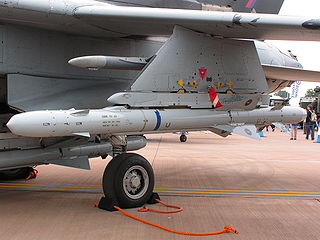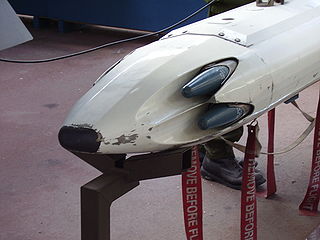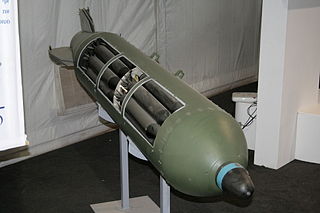
A cluster munition is a form of air-dropped or ground-launched explosive weapon that releases or ejects smaller submunitions. Commonly, this is a cluster bomb that ejects explosive bomblets that are designed to kill personnel and destroy vehicles. Other cluster munitions are designed to destroy runways or electric power transmission lines.
The GATOR mine system is a United States military system of air-dropped anti-tank and anti-personnel mines developed in the 1980s to be compatible with existing cluster dispensers. It is used with two dispenser systems—the Navy 230 kg (500 lb) CBU-78/B and the Air Force 450 kg (1,000 lb) CBU-89/B. Additionally the mines are used with the land- and helicopter-based Volcano mine system.

ALARM is a British anti-radiation missile designed primarily to destroy enemy radars for the purpose of Suppression of Enemy Air Defenses (SEAD). It was used by the RAF and is still used by the Royal Saudi Air Force. The weapon was retired by the UK at the end of 2013.

The CRV7, short for "Canadian Rocket Vehicle 7", is a 2.75-inch (70 mm) folding-fin ground attack rocket produced by Bristol Aerospace in Winnipeg, Manitoba. It was introduced in the early 1970s as an upgraded version of the standard U.S. 2.75-inch air-to-ground rockets. It was the most powerful weapon of its class, the first with enough energy to penetrate standard Warsaw Pact aircraft hangars. The CRV7 remains one of the most powerful air-to-ground attack rockets to this day, and has slowly become the de facto standard for Western-aligned forces outside the United States. Beginning in 2021, 83,303 stored Canadian CRV7s are slated for disposal having been removed from service from 2005 to 2007. In 2024 the Department of National Defence is considering donating the rockets to Ukraine as military aid to defend against the Russian invasion of Ukraine. An estimated 8,000 rockets have functioning warheads while the remainder could be used for parts or modification.

Brimstone is a ground or air-launched ground attack missile developed by MBDA UK for the UK's Royal Air Force. It was originally intended for "fire-and-forget" use against mass formations of enemy armour, using a millimetre wave (mmW) active radar homing seeker to ensure accuracy even against moving targets. Experience in Afghanistan led to the addition of laser guidance in the dual-mode Brimstone missile, allowing a "spotter" to pick out specific and the highest priority targets, particularly useful to minimise collateral damage when friendly forces or civilians were in the area. The tandem shaped-charge warhead is much more effective against modern tanks than older similar weapons such as the AGM-65G Maverick missile. Three Brimstones are carried on a launcher that occupies a single weapon station, allowing a single aircraft to carry many missiles.

Anti-runway penetration bombs are explosive weapons involving bombs or bomblets designed to damage or destroy runways, or otherwise render them unusable for aircraft.

The CBU-97 Sensor Fuzed Weapon is a United States Air Force 1,000-pound (450 kg)-class freefall Cluster Bomb Unit. It was developed and produced by Textron Defense Systems. A CBU-97 used in conjunction with the Wind Corrected Munitions Dispenser guidance tail kit is converted to a precision-guided weapon, and the combination is designated CBU-105.

The Mk 20 Rockeye II, CBU-99 Rockeye II, and CBU-100 Rockeye II comprise an American cluster bomb family which are employed primarily in an anti-tank mode against armored vehicles.

The Vickers 40 mm Class S gun, also known simply as the Vickers S or S gun, was a 40 mm (1.57 in) airborne autocannon designed by Vickers-Armstrongs for use as aircraft armament.

The JP233, originally known as the Low-Altitude Airfield Attack System(LAAAS), is a British submunition delivery system. It consists of large dispenser pods carrying several hundred submunitions designed to attack runways.

The RP-3 was a British air to ground rocket projectile introduced during the Second World War. The "3 inch" designation referred to the nominal diameter of the rocket motor tube. The use of a 60 lb (27 kg) warhead gave rise to the alternative name of the "60-pound rocket". Though an air-to-ground weapon, it saw limited use in other roles. They were generally used by British fighter-bomber aircraft against targets such as tanks, trains, motor transport and buildings, as well as by Coastal Command and Royal Navy aircraft against U-boats and ships.

A dual-purpose improved conventional munition (DPICM) is an artillery or surface-to-surface missile warhead designed to burst into submunitions at an optimum altitude and distance from the desired target for dense area coverage. The submunitions use both shaped charges for the anti-armor role, and fragmentation for the antipersonnel role, hence the nomenclature "dual-purpose". Some submunitions may be designed for delayed reaction or mobility denial (mines). The air-to-surface variety of this kind of munition is better known as a cluster bomb. They are banned by more than 100 countries under the Convention on Cluster Munitions.
The CBU-87 Combined Effects Munition (CEM) is a cluster bomb used by the United States Air Force, developed by Aerojet General/Honeywell and introduced in 1986 to replace the earlier cluster bombs used in the Vietnam War. CBU stands for Cluster Bomb Unit. When the CBU-87 is used in conjunction with the Wind Corrected Munitions Dispenser guidance tail kit, it becomes much more accurate, and is designated CBU-103.

The SNEB rocket is an unguided air-to-surface 68 mm (2.7 in) rocket projectile manufactured by the French company TDA Armements, designed for launch by attack aircraft and helicopters. It is also known as the SNEB rocket pod, and sometimes as the Matra rocket, due to it commonly being carried in pod-like launchers built by Matra.

A precision-guided munition is a guided munition intended to hit a specific target, to minimize collateral damage and increase lethality against intended targets. During the First Gulf War guided munitions accounted for only 9% of weapons fired, but accounted for 75% of all successful hits. Despite guided weapons generally being used on more difficult targets, they were still 35 times more likely to destroy their targets per weapon dropped.
The MAT-120 cargo bomb is a Spanish-produced cluster munition, fired from a 120mm calibre mortar produced by Instalaza SA. The main body of the round holds dual-purpose anti-tank/anti-personnel submunitions. The MAT-120 submunitions are unique in that to prevent the dangers of unexploded duds, there is a double redundant feature the manufacturer refers to as self-destruction and self-sterilization. This prevents unexploded MAT-120 submunitions from lying around becoming de facto landmines, dangerous to both combatants and non-combatants.

The British Aerospace Hawk 200 is a single-seat, single engine light multirole fighter designed for air defence, air denial, anti-shipping, interdiction, close air support, and ground attack.

The 2-inch RP, short for Rocket Projectile, 2-inch, Number 1 Mark 1, was an unguided rocket weapon developed by the Royal Navy in the 1950s. It is generally similar to contemporary rockets like the SNEB and FFAR, although somewhat smaller. It is sometimes known as the RP-2 or RN, but most often referred to simply as the 2-inch.















